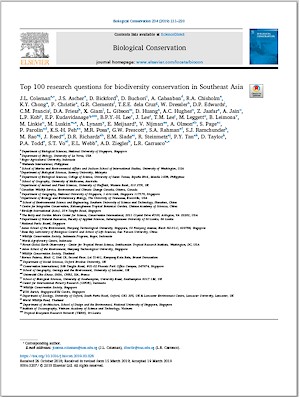| Journal Article |
 |
|
| Article Title | Top 100 research questions for biodiversity conservation in Southeast Asia | | Author | Joanna Louise Coleman, John Stoskopf Ascher, David Bickford, Damayanti Buchori, Annadel Cabanban, Ryan A. Chisholm, Chong Kwek Yan, Patrick Christie, Gopalasamy Reuben Clements, Thomas Edison E. Dela Cruz, Wolfram Dressler, David P. Edwards, Charles M Francis, Daniel A. Friess, Xingli Giam, Luke Gibson, Danwei Huang, Alice C. Hughes, Zeehan Jaafar, Anuj Jain, L.P. Koh, E.P. Kudavidanage, B.P.Y.-H. Lee, J. Lee, T.M. Lee, Matthew Leggett, Beria Leimona, Matthew Linkie, M. Luskin, A. Lynam, E. Meijaard, V. Nijman, A. Olsson, S. Page, P. Parolin, K.S.-H. Peh, M.R. Posa, G.W. Prescott, S.A. Rahman, S.J. Ramchunder, M. Rao, J. Reed, D.R. Richards, E.M. Slade, R. Steinmetz, P.Y. Tan, D. Taylor, P.A. Todd, S.T. Vo, E.L. Webb, A.D. Ziegler and L.R. Carrasco | | Year | 2019 | | Journal Title | Biological Conservation | | Volume | 234 | | Pages | 211-220 | | Call Number | JA00731-19 |
|
| Abstract: |
Southeast (SE) Asia holds high regional biodiversity and endemism levels but is also one of the world's most threatened regions. Local, regional and global threats could have severe consequences for the future survival of many species and the provision of ecosystem services.
In the face of myriad pressing environmental problems, we carried out a research prioritisation exercise involving 64 experts whose research relates to conservation biology and sustainability in SE Asia. Experts proposed the most pressing research questions which, if answered, would advance the goals of biodiversity conservation and sustainable development in SE Asia. We received a total of 333 questions through three rounds of elicitation, ranked them (by votes) following a workshop and grouped them into themes.
The top 100 questions depict SE Asia as a region where strong pressures on biodiversity interact in complex and poorly understood ways. They point to a lack of information about multiple facets of the environment, while exposing the many threats to biodiversity and human wellbeing. The themes that emerged indicate the need to evaluate specific drivers of biodiversity loss (wildlife harvesting, agricultural expansion, climate change, infrastructure development, pollution) and even to identify which species and habitats are most at risk. They also suggest the need to study the effectiveness of practice-based solutions (protected areas, ecological restoration), the human dimension (social interventions, organisational systems and processes and, the impacts of biodiversity loss and conservation interventions on people). Finally, they highlight gaps in fundamental knowledge of ecosystem function. These 100 questions should help prioritise and coordinate research, conservation, education and outreach activities and the distribution of scarce conservation resources in SE Asia. |
|